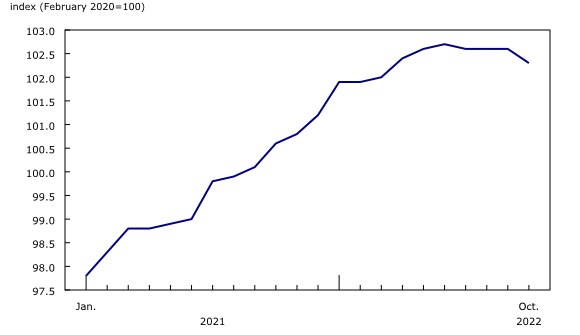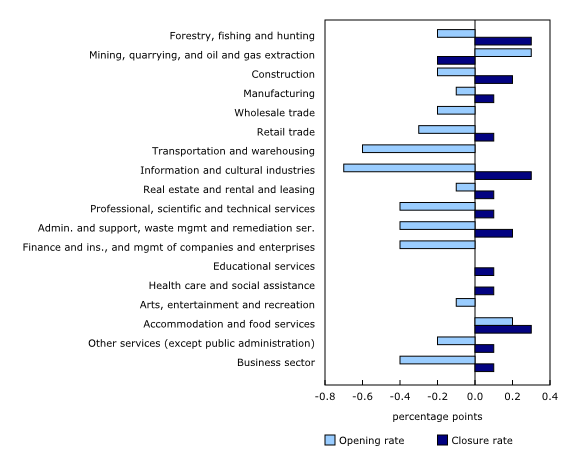Monthly estimates of business openings and closures, October 2022
Released: 2023-01-30
In October 2022, the number of active businesses declined by 0.3% (-2,563), following three months of no growth or negative growth. Excluding the beginning of 2020 with the onset of the COVID-19 pandemic, this was the first time on record that the number of active businesses did not post positive growth for four consecutive months. The contraction of the number of active businesses in October 2022 was due to the decline in the opening rate from 4.6% in September to 4.2% in October, combined with the slight increase of 0.1 percentage points in the closure rate (4.8%).
The number of active businesses dropped or was little changed in all industries in October. The decline of the overall number of active businesses was mainly driven by contractions in retail trade (-0.5% growth rate; -432 change in active businesses) and accommodation and food services (-0.5%; -338). They were followed by other services (except public administration) (-0.5%; -322) and construction (-0.2%; -301).
The variation of the number of active businesses in October is in line with the obstacles that businesses are expecting to face over the fourth quarter of 2022. According to the Canadian Survey on Business Conditions, the major obstacles businesses are expecting to face over the fourth quarter are rising inflation (58.4%), rising cost of inputs (48.1%) and recruitment and retention of skilled employees (41.7%). Businesses in retail trade (74.6%) and accommodation and food services (71.3%) are more likely to see inflation as a potential issue. Construction is the industry with the fourth-highest share of businesses expecting obstacles related to rising inflation (61.3%) and the second highest regarding recruitment and retention of skilled employees (52.0%).
In October, the decrease in the business opening rate was largely driven by the decline in the re-opening rate (-0.3 percentage points), whereas the entry rate held relatively steady. The business opening rate remained below its 2015-to-2019 historical average of 4.7% for the second consecutive month. The decline was led by professional, scientific and technical services (-0.4 percentage point change in opening rate; -477 change in business openings), followed by construction (-0.2 percentage points; -302), transportation and warehousing (-0.6 percentage points; -291) and retail trade (-0.3 percentage points; -274).
October was the third consecutive month in which the business closure rate settled above its historical average. The business closure rate changed little in most industries from September to October. Accommodation and food services (+0.3 percentage point change in closure rate; +168 change in business closures), construction (+0.2 percentage points; +155), professional, scientific and technical services (+0.1 percentage points; +128) and other services (except public administration) (+0.1 percentage points; +100) drove the slight increase in the overall business closure rate.
The series on temporary business closures and exits (or "permanent closures") is now updated to include data up to April 2022. The exit rate edged down 0.1 percentage points to settle at 1.6% in April 2022, slightly below its historical average of 1.7%. This was the first decrease in the exit rate since November 2021 (-0.2 percentage points).
With the exception of arts, entertainment and recreation (1.8% exit rate), which posted a 0.2 percentage point increase from March to April 2022, the exit rate dropped or held steady in all industries. In most industries, the exit rate was within 0.2 percentage points of its respective historical average. The industries in which the exit rate was furthest from and higher than its historical average were transportation and warehousing (2.7% exit rate vs. 1.5% historical average), real estate and rental and leasing (2.4% vs. 2.0%), professional, scientific and technical services (2.0% vs. 1.7%), and arts, entertainment and recreation (1.8% vs. 1.5%). The exit rate was below its historical average in mining, quarrying, and oil and gas extraction (1.5% exit rate vs. 1.9% historical average) and accommodation and food services (1.2% vs. 1.6%).
Note to readers
The June 2022 and subsequent geographic locations are based on the 2021 Census of Population geography.
April 2022's release introduced a new process for seasonal adjustment in the presence of the outliers generated by the response to the COVID-19 pandemic. The new process has a greater number of outliers that are explicitly recognized at the outset of the seasonal adjustment process. This leads to a greater number of outliers being taken into account than was previously occurring. Examinations of seasonally adjusted data using the new process show results that are more stable over time and produce smaller revisions.
Every new month of data leads to a revision of the previously released data due to such factors as the seasonal adjustment process and a new version of the Generic Survey Universe File (or vintage of the Business Register). As such, the estimates may vary compared with a previous release.
Openings are defined as businesses with employment in the current month and no employment in the previous month, while closures are defined as businesses that had employment in the previous month, but no employment in the current month. Continuing businesses are those that have employees in both months, and the active population in any given month is the number of opening and continuing businesses in that month. Re-opening businesses are defined as opening businesses that were also active in a previous month (that is, they closed in a given month and had positive employment in a subsequent month). In contrast, entrants are opening businesses that were not active in a previous month.
The definition of exits is based on the Longitudinal Employment Analysis Program (LEAP) annual exits. Because the LEAP definition can require up to 24 months of data for a business to be counted as an exit, projections of exits using predicted growth rates are implemented using a regression model of exits on closures of more than six months. As a result, there are no published exits in the last six months. A temporary business closure is the difference between closures and exits. For more information on temporary business closures and exits, see "Defining and measuring business exits using monthly data series on business openings and closures."
A business is defined as an enterprise operating in a particular geography and industry.
The vast majority of businesses operate in one industry and one location or geography. These businesses will be counted once at the national and provincial levels in the monthly estimates of openings and closures. For example, a retailer in Windsor, Ontario, will be counted as an active business in the Ontario estimates and once in the national estimates.
Some businesses can have multiple operations, and they can be in different industries and geographies. Such businesses can be counted more than once in the monthly estimates of openings and closures because they are active in multiple industries or geographies. For example, if a retailer has operations in both Alberta and Ontario, it will be counted as an active business in both provinces, but only once at the national level because it represents only one active firm. Similarly, a firm with retail and wholesale operations will be counted in both industries when individual industries are examined. However, when the business sector is examined, the firm counts only once because at that level it represents one firm active in the business sector.
Contact information
For more information, or to enquire about the concepts, methods or data quality of this release, contact us (toll-free 1-800-263-1136; 514-283-8300; infostats@statcan.gc.ca) or Media Relations (statcan.mediahotline-ligneinfomedias.statcan@statcan.gc.ca).
- Date modified:



